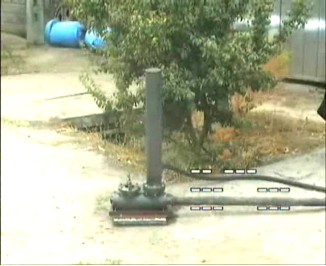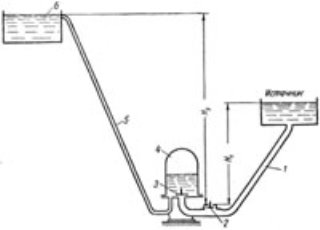The important meaning (importance) in regions dry climatic of a zone of Uzbekistan, is watering of grounds on mountain and foothill areas. The basic problem in these areas are the deficiency of irrigation water on the one hand and growing prices for electrical energy and fuel lubricant materials on the other hand. Together with it is necessary to note, that it is frequently enough to lift water on 4–5 meters. Besides businesses are going worse in maintenance of cattle-breeding pastures in mountain and foothill districts. In connection of this, the problem of reduction of expenses on delivery of water in remote places by introduction in manufacture power economic (or using alternative sources of energy) compact, independent, automatic pump installations, besides not polluting an environment, is one of the most urgent questions in an agriculture.
We offer to introduction the device, which represents compact, independent, the simple in operation automatically working engineless water lifting device — pump installation for mechanical water supply and allows to lift on height till 20–30 of meters some part of proceeding water at the expense of energy of the most proceeding water. By us is made and tasted the skilled sample of the device (Figure 1).

Figure 1. Sample of the pumping installation
Such water lifting device will allow to solve a problem of delivery of water in remote (for example, mountain) districts, where is at times leading of an electricity is complicated or there are no fuel-lubricant materials. Its most remarkable feature consists in its works without the help of the engine, more correctly, it simultaneously is the engine and water lifting device as well. As the engine, the device uses hydraulic energy of proceeding water. Therefore it can be established on a source of water having energy. Such sources serve high land springs leaving on a surface of ground on slopes of ravines, streams and rivers, and also irrigation ditches and canals. At the rivers and streams, irrigation ditches and canals for installation of this device the difference of water is created, for what the dam is arranged; at springs water collect in the reservoir located directly at a place of an output of a spring, which means on a raised place. Such installation can be used for submission of spring drinking water on raised sites, maintenance by water in small sites of grounds in mountain areas or for maintenance by technical water economic objects, farm. In our opinion, usage of such installations, especially for farms in mountain and foothill areas will give appreciable economic benefit.
The idea (purpose) is, that it is supposed to solve a problem described above, through compact and easily transfered, simple in operation of the water pump (hydroram), working automatically and independently without usage of electrical energy and fuel-lubricant materials.
The mankind uses force of falling water in various mechanical devices and, also, for reception of electrical energy for centuries. The hydrostations constructed on some rivers, continuously work tens years. Probably therefore, majority of the people deny even an opportunity of existence or creation essentially new power source from water.
From the usual point of view, the transformation of potential energy of water in kinetic (necessary, that something is rotated), occurs by itself. For this purpose it is enough to use a natural difference of heights of the river or is artificial to create it there, where it is possible. Thus it is clear, that water should flow necessarily downwards, that is on slope. His clear that the force of water depends on difference of heights of current. A whole science «water-power engineering» about use of energy of falling water exists for a long time.
In 1775, in one of the English magazines clause J.Whitehurst with the description of the device invented and executed by him in 1772 has appeared. The device allowed to carry out water from small height on significant without leading of any additional energy, only at the expense of use of potential energy of water. For the account, so-called, phenomenon of hydraulic impact. But the device could not then work completely automatically. This lack was eliminated in 1776 by the inventor of an air sphere by the French J.Montgolfier. In 1797 he received the patent for the invention. It is interesting, that in the same year the patent for the similar device has received M.Bulton in England. In 1809 the similar patent was received in America by the inventors J.Cerneay, S.Hallet. And already in 1834-y the American (H.Strawbridge) has started industrial variant of the similar device in mass manufacture. However now it is considered, that the invention made by the French J.Montgolfier is the device which has received subsequently the name hydraulic ram.
With the originality and simplicity of work hydraulic ram some time strongly attracted the scientific theorists and practicians (Figure 2).
During XIX of century many theoretical researches of hydraulic ram were executed, but up to the end of 1900 all of them rested against uncertainty of the theory of hydraulic impact in pipes and consequently did not give correct results. In 1804 Eitelvein (Germany) has put more than 1000 experiences and has published a number of empirical conclusions and formulas, which majority, was found out already before, was not suitable for designing. Though the fact of existence of the phenomenon of hydraulic impact was known still in XVIII century, the theory of this phenomenon was developed for the first time by Russian scientist Nikolay Jukovski. His theoretical conclusions professor has checked up and confirmed by special experiences in 1897–1898 years. In 1898 his theory for the first time was published in «the Bulletins of a Polytechnical society».

Figure 2. Scheme of the hydraulic ram: 1- supplying pipe line, 2 -striking valve, 3- admission valve, 4- air valve, 5- pipe line; 6- receiving tank; Нп — height supplying tank; Нн -a height
In 1901 Italian engineers Alievi has published practically the same theory «of hydraulic impact», but with reference to pipelines of various power installations. However experiences which have been carried out Jukovski and, later, other researchers in the different countries, completely have proved the basic rules of his theory. But it also, has not received wide illumination both recognition after publicating. The researchers and enthusiasts of hydraulic ram from year to year still put experiments and found for the purposes the different not generalized empirical formulas. In America, Australia and in a number of other western countries «hydraulic ram», as the device capable free-of-charge to swing water on height, has received development in melioration and for various household needs under the name «ram-pump». In these states and now there are some tens small companies specializing on manufacture and sale «ram-pump». Many from them at installation of the mechanisms use the extremely own formulas.
In Russia, at once after the publication of the theory «of hydraulic impact» by Jukovski, the works on creation and development of the theory of «hydraulic ram» were successfully continued by his students and followers: B.Bubekin’s, B. Behmetev’s. In particular, on the basis of results of special experiences above «hydraulic ram, executed by Bubekin in 1903–1907 years, the professor Jukovski has given the correct circuit of work «ram» during a forcing, having stated it in the report «the New theory hydraulic ram» in a Mathematical society (community) of September 18, 1907. Further, the professor Bakhmetya, on the basis of the same theory of Jukovski and experiences of Bubekin, in the work «Introduction in study of the unsteady movement of a liquid» has given correct processing of the period of dispersal of water in researches Navler and Harza. Association of the theory however is final and practice the professor Chistopolsski, created first, and about the present days the only known and reliable, method of theoretical account of this device has made in 1930 in the work of «hydraulic ram». This method is completely proved by results of numerous tests. The following years, with development of oil extracting and electric power industry, «hydraulic ram», as the device for free-of-charge rise of water, unfortunately, was forgotten, in spite of the fact that till 50 years ХХ of century in Russia there were factories making these devices in carload volumes for melioration. By the end of century «hydraulic ram» was only mention in the Large Soviet Encyclopedia.
On traditional technology the potential energy of water is transformed to electrical energy, which is transported through lines of electrotransfers on the large distances and then is used for a drive of pump installations for a raising of water. The difference of offered idea consists in the potential energy of water is used here for a raising of a part of this water on some height without additional transformation to electrical energy. Thus the ecological safety is kept, the harmful emissions are excluded, the large economy of means takes place.
Real expected results of the given investment project — improvement of maintenance and decrease of the cost price of production and submission of irrigation and drinking water on cattle-breeding pastures at the expense of exception of expenses on the electric power and service. One installation offered by us to introduction with productivity from 4000 about 8000 l/day can supply with water up to 100 men or water large and fine horned cattle in pasturable conditions during migration.
As in a national economy of our Republic and Republics of Central Asia the agrarian sector prevails, the independent maintenance by water of the village population and agricultural animals is a most urgent question. The village population of Republics of Central Asia has an opportunity to receive compact and easily leading, simple in operation and water pump, not requiring overhaul working automatically and independent without use of electrical energy and fuel-lubricant materials. The efficiency of realization of the given project can be estimated by decrease of the cost price of manufacture of agricultural and cattle-breeding production at the expense of decrease of expenses on water supply (economy of the electric power, fuel-lubricant materials, exception motor transportation supply of water on pastures).
Now we conduct work on research of various designs hydraulic ram with the purpose of use them in a national economy of republic.
References:
- А. И. Лаврентьев, Л. Я. Кашеков. Механизация водоснабжения животноводческих ферм. СЕЛЬХОЗГИЗ, М. — 1954;
- А. Ф. Галкин. Комплексная механизация производственных процессов в животноводстве. М., «КОЛОС» 1969.
- C.Саудхуджаев, Н. Саидхуджаева. Водоподъемные установки, не затрачивающие энергию. Узбекистана № 8. Ташкент. 2008г
- Материалы Интернета.

